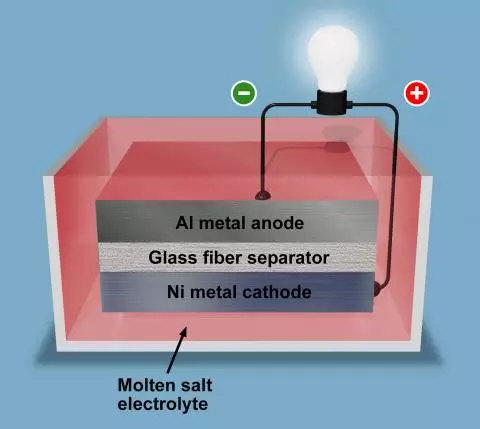Scientists continue to explore advanced battery technologies that could help us unlock the full potential of renewable energy, working to address the intermittent nature of power coming from the sun and wind. A team at Pacific Northwest National Laboratory (PNNL) has come up with a new design that ticks a few important boxes in this area, demonstrating a type of "hibernating" battery that can preserve its energy for months at a time.
The type of energy storage technology at the center of this research is known as a molten-salt battery. These have been around for more than 50 years in various forms, and are fancied as a grid-scale storage solution for renewable energy due to their low cost and use of commonly available materials.
These devices use molten salt as the electrolyte, which is the solution that carries the electrical charge between a battery's two electrodes, the cathode and the anode. Keeping the electrolyte at high temperature keeps the salt in a molten state and sees it flow like a liquid, but at room temperature it becomes solid. The PNNL team has leveraged these attributes to produce what's described as a temperature-based hibernating battery.

The device consists of an aluminum anode and nickel cathode, which are immersed in a molten salt electrolyte doped with sulfur for an extra capacity boost. The battery is charged by heating it to 180 °C (356 °F), which sees ions flow through the liquid electrolyte to generate chemical energy. Cooling the battery to room temperature solidifies the electrolyte and freezes the ions in place, locking in the energy until the battery is reheated to get the energy flowing again.
For this reason, the scientists also refer to the device as a "freeze-thaw battery," and though the prototype is only around the size of a hockey puck, they are optimistic about its potential to be scaled up. Its theoretical density is 260 Wh per kilogram, higher than today's lead-acid and flow batteries, and its energy is stored at a materials cost of around US$23 per kWh, which the team hopes to bring down to around $6 per kWh by incorporating iron into the design. In testing, the battery retained 92 percent of its capacity over 12 weeks.
“It’s a lot like growing food in your garden in the spring, putting the extra in a container in your freezer, and then thawing it out for dinner in the winter,” said first author Minyuan “Miller” Li.
We have seen a couple of promising innovations in molten-salt battery technology of late. Typically, molten-salt batteries use a ceramic separator between the anode and cathode to control which molecules are allows to pass through. In 2018, an MIT team showed how a more durable steel mesh could be used instead. Last year, a team at Sandia National Laboratories also demonstrated a cheaper version that could operate at far lower temperatures than conventional designs. The PNNL team has also opted for an alternative to the ceramic separator used in typical molten-salt batteries, going with fiberglass instead, which they say is cheaper and more durable.

Eventually, the scientists hope the technology can come to offer a form of seasonal energy storage, collecting energy at one time of the year for use in another. And because the battery can sit idle while maintaining most of its stored energy, it would only need to be charged and discharged a few times a year.
“You can start to envision something like a large battery on a 40-foot tractor-trailer parked at a wind farm,” said co-author Vince Sprenkle. “The battery is charged in the spring and then the truck is driven down the road to a substation where the battery is available if needed during the summer heat.”
The scientists have filed a patent for the technology and have published their research in the journal Cell Reports Physical Science.





